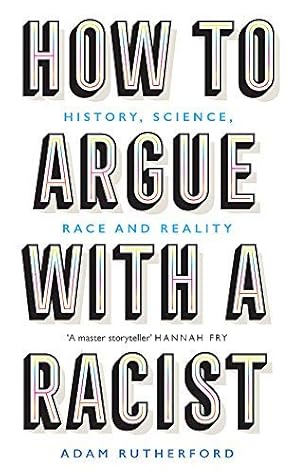More on this book
Community
Kindle Notes & Highlights
Read between
December 7 - December 13, 2020
The idea that we were ancestrally dark skinned before diversifying as we crept around the globe is now known to be incorrect. Not only were we diverse in our skin colour long before the dispersal from Africa, we were diverse in our skin colour before we were our own species.
What we see with our eyes is the merest fraction of a human.
When all you’ve ever known is privilege, equality feels like oppression.
over a 500-year period, you have 1,048,576 ancestors. By a thousand years ago, you have 1,099,511,627,776 – that is, over a trillion. This number is about ten times more people than have ever existed.
the answer to this puzzle is obvious: our family trees coalesce and collapse in on themselves as we go back in time. You certainly must have a trillion positions on your family tree, but the further you go back, the more frequently these positions will be occupied by the same individuals multiple times.
The fact that multiple positions are occupied by the same people indicates that the notion of a tree is again not the most accurate metaphor for describing genealogy: trees only ever branch, but family trees contain loops.
we reach a mathematical certainty referred to as the genetic isopoint. This is the time in history when the entire population is the ancestor of the entire contemporary population today. For the people of Europe, the isopoint occurs in the tenth century. In other words, if you were alive in the tenth century in Europe, and you have European descendants alive today, then you are the ancestor of all Europeans alive today
Despite the concept of the isopoint, we don’t randomly mate in a globally distributed full shuffle.
Over the generations, descendants begin to shed the DNA of their actual ancestors. The amount that vanishes is cumulatively huge: you carry DNA from only half of your ancestors eleven generations back. Genealogy and genetic genealogy are not perfectly matched, and progressively grow apart as we go back in time. It is therefore possible that you are genetically unrelated to people from whom you are actually descended as recently as the middle of the eighteenth century.
The difference in regionally mediated success is culture. The utter dominance of Finnish long-distance runners in the first half of the twentieth century ended because the culture of running dissolved.
having the right genes is necessary but not nearly sufficient to account for the dominance of any group of athletes in any sport.
the proportion of cognitive abilities that can be attributed to genetics rather than other things is somewhere between 40 per cent and 60 per cent.
single genes frequently do many things in the body at different times. Genes work in networks and cascades and hierarchies. And so for traits that can be summarised in a simple metric – height, eye or skin colour – what we find via GWAS is that a handful, dozens or even hundreds of genes play a small but cumulative role.
Polygenic scores help us to understand the genetics of any human trait, including complex diseases, though not yet with enough detail to warrant clinical intervention.
The evidence for selection of genes for intellect in Jews is weak. Is it not simply more scientifically parsimonious to suggest that a culture that values scholarship is more likely to produce scholars?
a society that champions long-distance running as a pathway to economic and cultural success, with highly successful runners already in place, a multitude will chase them.
we are social beings who have offloaded so much of our behaviour from our bodily hardware to our cultural software, and nowhere is this more apparent than in our intelligence.
People are born different, with different innate capabilities and potential. How these abilities cluster within and between populations is not easily explained by fundamental biology, by genetics. Instead, when digging into the data as best as we can, the answers lie not in DNA, but in culture.


